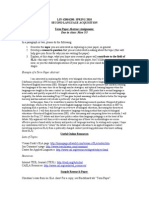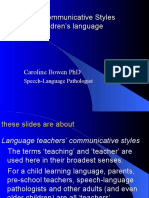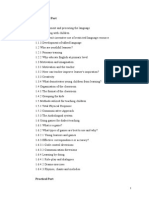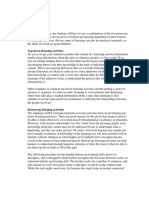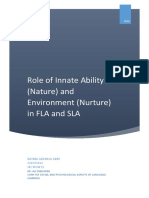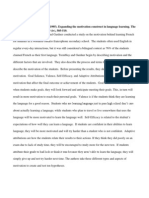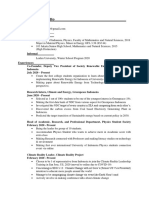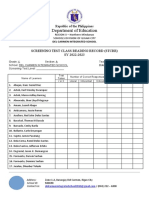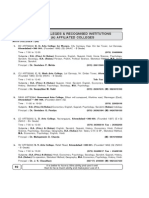SLA - Final Exam
SLA - Final Exam
Uploaded by
saxmachine1411Copyright:
Available Formats
SLA - Final Exam
SLA - Final Exam
Uploaded by
saxmachine1411Original Description:
Original Title
Copyright
Available Formats
Share this document
Did you find this document useful?
Is this content inappropriate?
Copyright:
Available Formats
SLA - Final Exam
SLA - Final Exam
Uploaded by
saxmachine1411Copyright:
Available Formats
LIN 4200/6200, SPRING 2010 SECOND LANGUAGE ACQUISITION FINAL EXAM Name: _Bethany Deibler_______________ Directions: Please download
a copy of this Word file and type your answers directly onto the form. When you have completed the exam, print it out and brin it to class on !une " to turn in. #ood luc$% SHORT-ANSWER QUESTIONS (10 p ! "#$%& &ead the ei ht 'uestions below and then $%''!" FI(E ' #)!*"+. (ndicate which five you have chosen by leavin the full 'uestion before your answer)you may delete the three 'uestions you choose not to answer. Please do not exceed *++ words in each answer. ,- Discuss and describe a lan ua e teachin method that is clearly premised on the belief that second lan ua e learnin is similar to first lan ua e learnin . ./hapter 01he Direct 2ethod is directly related to the idea that people can learn their second lan ua e the same as the first. 1his method does away with all translation and explicit rammar lessons. 1he students are to simply listen and mimic the teacher. 1he teacher will start with very simple sentences and slowly chan e words and add new vocabulary for the students to learn. 1his is similar to first lan ua e learnin in that children, when learnin a lan ua e, have nothin to translate from and can only listen and imitate the sounds they hear around them. 1his method is more practical for students who are loo$in for a course that will prepare them for livin in a place where the lan ua e is spo$en. 3owever, for a student who is hopin to learn how to write or be involved in the academic side of the lan ua e, this method will not be satisfied. While they try to imitate first lan ua e learnin , it can never duplicate it exactly because there are many factors that cannot be the same as the learners already have a first lan ua e. 4ne of these factors is the fact that the adult already has a concept of lan ua e and a way to communicate. 0- Discuss two theoretical considerations .neurobiolo ical, co nitive, affective, or lin uistic- in explainin why5how children learn lan ua es differently than adults do. ./hapter 67n 7ffective consideration as to why children learn differently from adults has to do with e ocentricity. /hildren are very e ocentric8 everyone and everythin revolves around them. 1hey don9t care what other people thin$ and often everythin is :mine%; <an ua e e o is a term used to tal$ about the identity a person has in their lan ua e use. 4ften
people are so proud of their lan ua e or accent in a different lan ua e that they do not want to chan e it. 3owever, this also relates to children when they are buildin this lan ua e e o. 1hey try out different words and ideas and aren9t afraid to ma$e mista$es. 7s they row older, other children be in to =ud e and ma$e fun of them for mista$es and peculiarities. 1his causes them to become cautious and try not to ma$e mista$es to avoid humiliation. 1his stic$s with humans the rest of their lives, thus adults have a harder time experimentin with the lan ua e and ma$in mista$es. 7 <in uistic consideration is that adults already have a lan ua e, and the first lan ua e tends to interfere with the <0 learnin process. 7dults will have both rammatical and phonolo ical difficulties with the second lan ua e as they have solidified the first lan ua e rammar and sounds already. /hildren do not have any other lan ua e s$ills yet and are able to ma$e every sound possible, whereas adults have lost their ability to ma$e certain sounds because they are not utili>ed in their native lan ua e. 1his is not to say that children learn perfectly and never ma$e mista$es. (n fact, adults often ma$e the same mista$es as children do when learnin a new lan ua e. 6- Discuss one aspect of why second lan ua e ac'uisition is necessarily tied to the process of second culture ac'uisition .e. ., culture shoc$ and ?<7, social distance and ?<7, collectivist5individualist societies and ?<7, etc.-. ./hapter "/ulture is a bi part of a lan ua e. ?tudents can learn a lan ua e from a textboo$ with no cultural references, but if they try to use that textboo$ lan ua e in real life, they will most li$ely run into some problems. (t is impossible to be fluent in a lan ua e with no $nowled e of the culture. Not only do dictionaries leave out cultural connotations of words, but lan ua e chan es over time as well. @ormal and informal speech is also an important thin to learn with a new lan ua e. 4ther thin s that may vary by culture may be nonAlin uistic factors such as eye contact or distance from the person you are spea$in to. 1eachin culture alon with the lan ua e is important for students if they are oin to live in said culture. (t will help them to avoid or lessen the effect of culture shoc$. (f students do not understand the culture or connotations of certain words, they could et into some serious trouble, but not understand a thin of what was oin on. /ulture is hard to teach, but it is important for students to be aware, especially if travelin to spea$ the lan ua e on a daily basis in a forei n country. B- Provide an extended definition of :communicative competence; by explainin , in detail, @i ures C., and C.0 .Bachman, ,DD+- on pa es 00,A000. ./hapter C/ommunicative competence differentiates between or ani>ational and Pra matic competence. 4r ani>ational competence is how well the student understands the rule based side of the lan ua e. #rammatical competence falls under this cate ory and has to do with the syntax, morpholo y, and phonolo y of the lan ua e8 the lin uistic side. 1extual competence also falls under the or ani>ational side and has to do with the lar er
discourse part of the lan ua e. /an the student read and understand how full para raphs or articles o to etherE /an the student produce a lo ically or ani>ed essayE 1he Pra matic side of /ommunicative competence has to do more with the meanin s of words in a social or cultural context. (llocutionary and ?ociolin uistic /ompetence are under this cate ory. 1he (llocutionary aspect refers to the $nowled e that the student has of how to use the lan ua e8 as in, what the correct response is to a certain 'uestion. 1he sociolin uistic competence is the $nowled e the student has of different dialects, how to properly address different people, and the different cultural meanin s of words. 7nother way to loo$ at it is from the top down. ?tartin with the student9s $nowled e of the world and combinin it with the $nowled e of the lan ua e, we can assess how the student will respond in a certain situation. *- Write and answer your own 'uestion based on the material in /hapter ,+. 7s lon as the 'uestion as$s about a ma=or aspect of the chapter and your answer provides insi ht and careful thou ht, the 'uestion5answer will be accepted. ./hapter ,+Pic$ one of the :hot topics; in ?<7 research from pp. 0D,A6 and explain why it is controversial. @rom your point of view, which side is ri htE 4r is there a combinationE 7wareness or conscious learnin has been debated over the years. People debate whether it is important to $now and understand that you are, in fact, learnin somethin . /hildren and infants enerally learn unconsciously and it often seems that when you try to teach them consciously, it doesn9t have an effect on them. 4ver the years people have ar ued that students should never be consciously aware that they are learnin 8 this most specifically refers to the forms of the lan ua e. 1his would be similar to the 7udioA lin ual or Direct 2ethod that do not explicitly teach the rammar rules. 4n the one hand, it is helpful for students to focus on the forms in the lan ua e some, but not so much that they can9t thin$ about the meanin of what they are tryin to convey. 1here needs to be a balance between the two. (n my personal experience, ( have never thrived in a situation of learnin a lan ua e without $nowin rammar rules. ( learned a couple of words and phrases, but it was a bit disconcertin that ( didn9t $now any rules. (t seems that learnin with no awareness of forms would ta$e a much lon er time and not be very efficient. 4n the other hand, ( have often otten so cau ht up in tryin to remember the correct form of a word that ( for et the rest of what ( was attemptin to communicate. <i$e many thin s in lan ua e learnin , there needs to be a balance of awareness present in the students.
LONG-ANSWER QUESTIONS (2, p ! "#$%& &ead the three 'uestions below and then $%''!" TWO ' #)!*"+. (ndicate which two you have chosen by leavin the full 'uestion before your answer)you may delete the one 'uestion you choose not to answer. Please do not exceed ,+++ words in each answer. ,- (ma ine you are at the be innin sta es of learnin a second lan ua e. (n your classroom learnin contexts, would you prefer to be tau ht by a nativeAspea$er or a nonAnative spea$er of the tar et lan ua e you are learnin E Does your answer depend on the specific type of learnin context .F?< vs. F@< context, for example-, the material you are tryin to learn .material for an exam vs. pra matic communication s$ills, for example-, or the sta e of learnin you inhabit .be innin , intermediate, advanced-E 7re there any other factors that determine your choiceE 7s a student, ( would prefer to have a nonAnative teacher. @irst, the teacher will be able to relate to the difficulties of learnin the lan ua e. Fspecially if the teacher is a native spea$er of the same lan ua e as me, s5he can directly relate to the phonolo ical problems ( will have because s5he will have already one throu h .and hopefully mastered- the process. Fspecially in the be innin sta es of lan ua e learnin , ( would li$e someone to spea$ to in my own native lan ua e if ( have 'uestions. Perhaps when ( et to the hi her levels of lan ua e learnin it would be nice to have someone who is a native spea$er. 1hen ( can learn better all the cultural connotations that words have as well as improve my accent in the lan ua e. People may ar ue that they want native spea$ers to teach them so they can learn directly from the best of spea$ers, the real deal. Gnless the students are ready to ta$e up the challen e of bein completely immersed in a new lan ua e with no previous $nowled e, this situation would be very overwhelmin and discoura in for students when they don9t understand anythin . 2any pro rams that are active today don9t necessarily care if the teacher sent from the nativeAspea$in country has any concept about teachin , rammar, or lan ua e other than what they have rown up usin . (f native teachers come to teach, they should have proper trainin in teachin and some $nowled e of the lan ua e roup they are oin to teach. ?tudents should be able to as$ 'uestions to their teacher both in and out of class in the students9 forei n lan ua e in order to clarify and points that were misunderstood durin class. 1he settin of the classroom, whether F@< or F?<, depends on the motivation of the students. ?tudents in the F@< settin will be the students who have moved somewhere possibly to et a =ob and learn the lan ua e8 they will be up to the challen e of bein in the previously mentioned situation of complete immersion. 7 native spea$er is most practical for them in this situation as it forces them to use their tar et lan ua e the ma=ority of the time. 1hey would also benefit from a native teacher who can differentiate between dictionary forms of words and the slan or cultural uses that students are more li$ely to hear out of the classroom. 1he pra matic
communication s$ills will be important to avoid misunderstandin s due to word usa e. 7n F?< settin is where the students9 motivation mi ht not be as stron . 1hey may ta$e the course =ust for the fun of learnin a new lan ua e, or as a re'uirement for educational re'uirements. 1hey will not be forced to use the lan ua e outside of the classroom and they are often much more lowA$ey than F@< settin s. (n this case, a nonAnative spea$er would be better to help the students alon and possible provide more motivation for them to continue usin the lan ua e. ?tudents in this settin will most li$ely be tau ht how to pass a test in order to complete their education. 1hey will be tau ht test $nowled e, not pra matic uses. 4verall, for be innin students, a nonAnative teacher will benefit the students much more8 however, as they improve in their lan ua e s$ills, a native teacher may benefit them more as they et into the more complex pra matic and pronunciation issues.
0- Perform an error analysis on a sample student essay .see the :1erm Paper; tab in Blac$board and print off a copy of :Fssay for Frror 7nalysis;-. (n doin so, identify at least six errors in the essay and then use <ennon9s .,DD,- procedure .pp. 0H0A0H6- to analy>e these errors, explainin , for each, the type of error, the level of lan ua e, whether the error is global or local, and the dimension. 7s a second part of this 'uestion, ima ine that you will meet with the writer of this essay in a 0+Aminute oneAonAone conference. Which errors would you discuss first and whyE Which, if any, would you have the student selfAcorrect .i.e., on his5her own for homewor$ instead of explicitly in the conference- and whyE 1he first noticeable mista$e is the extra additions of the plural forms .As-. :the most important thin s; could wor$, but the verb :is; does not match the plural form. :7lcohols; is a mass noun and enerally referred to as =ust alcohol. :7dvices; also is also a mass noun and should be =ust advice. 1his error is on of addition, the plural is not needed. 1his is a morpholo y error and is local, it can be understood what the student is tryin to convey. 1he domain is at the word level, and the extent is the plural mar$er, s. 1he second mista$e noted is the incorrect endin s on nouns. :3appily; in the end of the first para raph and be innin of the second should =ust be happy. 1he student uses the correct for at the end of the second para raph a ain, so it is stran e that it is used earlier incorrectly. :@inishin ; in the third para raph, since it comes after :to;, it should be :to finish;. 1his error is a substitution error of rammar. 3owever, it is a local error as the meanin is still understood. 1he domain is at the word level, and the extent is the endin s of the words, Aly, and Iin . 1he third mista$e is the absence of the word :a;. 7t the end of the second para raph it should be :a farmer; and in the middle of the third, :a power point slide expert;. 1his is
an omission error of the lexicon. (t is local, and the domain is the phrase8 the extent is the indefinite article. 7 fourth mista$e was a couple of spellin errors. 1he first, :feels; in the second para raph should be field. 7lso, the word :advice; in the third para raph should be advise. (t is hard to tell if this is a spellin mista$e or confusion of a noun and verb. 1his is an error of either substitution or orderin concernin the letters, but more specifically an ortho raphy error. #enerally these are local errors, as lon as the word is still reco ni>able. 1he domain is on the word lever, and the extent is to et the spellin correct, possibly addin or chan in letter order. 7 fifth mista$e is incorrect tenses. (n the second para raph, :you cannot et anythin you wanted;, the :cannot; and :wanted; do not match. 4ne of these words should be chan ed either both to past tense or present tense. 1he end of the third para raph also has :he always help us;. 1his should be :helped; in the past tense. 1his error is a substitution error havin to do with rammar. 1hese two examples are local errors. 1he domain is in the phrase level, and the extent is the tense of the verb. 7 sixth mista$e is the use of vocabulary. (n the third para raph, :learn; should be attend, because you cannot learn a class. 1wo sentences later, :it will ma$e you funny;. 1he meanin of this is a bit confusin . 1his error is a substitution error as well and has to do with the student9s lexicon. 1hese types of errors are lobal. 1he first one, with learn can be understood8 however :it will ma$e you funny; is unclear. @unny has many different connotations, it can mean somethin that ma$es you lau h, or somethin isn9t 'uite ri ht. (t is unclear what the intentions of the student were. 1he domain is the phrase, and the extent is the vocabulary. (n a meetin with this particular student, first of all, ( would point out the errors that were lobal. (n this particular paper, there was only one with the use of the word funny. 1he student should either chan e the word, or explain what s5he means. ( would also point out the spellin errors. 1his can 'uic$ly become lobal and affect the student9s meanin if not fixed. @or the student to selfAcorrect, ( would underline either the word or sentence that had the error and let the student decide what the error was and fix it. (f this process is to be repeated several times, the first couple oneAonAone conferences, ( would have the student selfAcorrect durin the meetin in order to et the idea of what is expected.
You might also like
- ELTM Chapter 6 (Teaching Across Age Levels)Document5 pagesELTM Chapter 6 (Teaching Across Age Levels)DikaNo ratings yet
- Les Loisirs Unit PlanDocument10 pagesLes Loisirs Unit Planapi-324919699100% (2)
- CW1 Assignment FY027 BriefDocument3 pagesCW1 Assignment FY027 BriefShahidUmar50% (2)
- Directions:: Due in Class: Mon 5/3Document1 pageDirections:: Due in Class: Mon 5/3saxmachine1411No ratings yet
- The Filipino FamilyDocument11 pagesThe Filipino FamilyTiger Knee97% (38)
- 2021-22 School CalendarDocument1 page2021-22 School CalendarJeremy TurnageNo ratings yet
- Lanaguage Diversity Plan Edit 12-16Document7 pagesLanaguage Diversity Plan Edit 12-16api-242984358No ratings yet
- Science Inquiry Final DraftDocument15 pagesScience Inquiry Final Draftapi-315608864No ratings yet
- There Are Many Benefits To Be Gained From Internationalisation of NursingDocument16 pagesThere Are Many Benefits To Be Gained From Internationalisation of NursingcassandraNo ratings yet
- SPEDI0''.': Lines IDocument12 pagesSPEDI0''.': Lines IMarina YgusquizaNo ratings yet
- Accelerating Adult Language Learning-Spiderweb Method-Cecilia SassoneDocument7 pagesAccelerating Adult Language Learning-Spiderweb Method-Cecilia Sassonececisassone100% (2)
- Planning CommentaryDocument5 pagesPlanning Commentaryapi-253401574100% (1)
- How Children FailDocument172 pagesHow Children Failmeb05100% (2)
- FAQ Concepts About VocabularyDocument8 pagesFAQ Concepts About VocabularynajamulsaherNo ratings yet
- Oral Communication Skills EssayDocument5 pagesOral Communication Skills EssayFrancoise AngeliqueNo ratings yet
- Microteaching 3 - Best Lesson PlanDocument6 pagesMicroteaching 3 - Best Lesson Planapi-235829936No ratings yet
- Understanding Poverty Chapter 2Document5 pagesUnderstanding Poverty Chapter 2liuwNo ratings yet
- Mid Term 11th English Set-ADocument15 pagesMid Term 11th English Set-Adalimasingh99No ratings yet
- Teaching Across Age LevelsDocument8 pagesTeaching Across Age LevelsAurelioNo ratings yet
- Chapter 3Document26 pagesChapter 3jhana9954No ratings yet
- Teaching Intercultural CommunicationDocument24 pagesTeaching Intercultural Communicationapi-2524474420% (1)
- Adult Communicative Styles and Children's LanguageDocument40 pagesAdult Communicative Styles and Children's LanguageKNjyothiNo ratings yet
- Game 1Document26 pagesGame 1Gabriela PredaNo ratings yet
- Fdocuments - in Celta TasksDocument23 pagesFdocuments - in Celta TasksvelavanNo ratings yet
- Listening Subskills 2Document4 pagesListening Subskills 2geethark12No ratings yet
- Begae 182 emDocument11 pagesBegae 182 emArunNo ratings yet
- مادة اثرائية محلولة في اللغة الانجليزية للصف الحادي عشر علمي وأدبي الفصل الأولDocument39 pagesمادة اثرائية محلولة في اللغة الانجليزية للصف الحادي عشر علمي وأدبي الفصل الأولmoayad.saramahNo ratings yet
- Student 1Document5 pagesStudent 1Gia Nella BossoNo ratings yet
- CLT EssayDocument4 pagesCLT Essayjamilnurdin954100% (2)
- High Order Thinking SkillDocument28 pagesHigh Order Thinking SkillrathitaNo ratings yet
- Asynchronous Activity Pre FinalDocument2 pagesAsynchronous Activity Pre FinaldncblzmNo ratings yet
- Running Head LITERACY MATTERS 1Document6 pagesRunning Head LITERACY MATTERS 1api-535200878No ratings yet
- Test Bank For Introduction To Children With Language Disorders, An, 4/E 4th Editon. Vicki A. Reed PDF Download Full Book With All ChaptersDocument39 pagesTest Bank For Introduction To Children With Language Disorders, An, 4/E 4th Editon. Vicki A. Reed PDF Download Full Book With All Chaptersshouhaamedza100% (4)
- HLALChap 3Document27 pagesHLALChap 3Camila MacielNo ratings yet
- Eng 4 - G2 - 20191 - AssvDocument6 pagesEng 4 - G2 - 20191 - AssvJóse Villabón.No ratings yet
- Reflective Lesson PlanDocument6 pagesReflective Lesson PlanstraitmiNo ratings yet
- Research Proposal and RationaleDocument3 pagesResearch Proposal and RationaleGrace BullequeNo ratings yet
- Reading Skills: For Pale English Level 3 Adapted FromDocument13 pagesReading Skills: For Pale English Level 3 Adapted FromAhuitz Gabriel Gallardo ValenzuelaNo ratings yet
- Hree Models of Reading StrategiesDocument9 pagesHree Models of Reading StrategiesJeianne Decerie MiguelNo ratings yet
- 7 DA Talk and Trust 2015Document25 pages7 DA Talk and Trust 2015simianchanNo ratings yet
- Impact Study2Document24 pagesImpact Study2api-250107317No ratings yet
- Chapter 1 (Research)Document4 pagesChapter 1 (Research)Janella MatarongNo ratings yet
- History of Teaching and Learning A LanguageDocument3 pagesHistory of Teaching and Learning A LanguageTeresa Montaño OrtizNo ratings yet
- Tessa Woodward.Document11 pagesTessa Woodward.Sontac NicoletaNo ratings yet
- Tpa 2 - Designing InstructionDocument40 pagesTpa 2 - Designing Instructionapi-31773880791% (11)
- Tipos de Preguntas y Ejemplos Pruebas Saber PRO (ECAES) - Lenguas Modernas - Inglés v4Document4 pagesTipos de Preguntas y Ejemplos Pruebas Saber PRO (ECAES) - Lenguas Modernas - Inglés v4kenfelipNo ratings yet
- Levels I Abstraction of LanguageDocument12 pagesLevels I Abstraction of LanguageYugal ShresthaNo ratings yet
- Tefl 2Document6 pagesTefl 2nabilahNo ratings yet
- Deaf Awareness Lesson PlansDocument41 pagesDeaf Awareness Lesson PlansAdina PatrasNo ratings yet
- Children Vs Adult in SLADocument8 pagesChildren Vs Adult in SLACindra WahyuniNo ratings yet
- Class VII English Honeycomb (Poem) Chapter 4. ChivyDocument29 pagesClass VII English Honeycomb (Poem) Chapter 4. ChivyArtham ResourcesNo ratings yet
- Introducing Little Kids to the Big Ideas of Mathematics: A Rad Makeover for Teaching MathFrom EverandIntroducing Little Kids to the Big Ideas of Mathematics: A Rad Makeover for Teaching MathNo ratings yet
- Teaching ListeningDocument2 pagesTeaching ListeningMesya SukmaNo ratings yet
- ENG 520. Preliminary ExaminationDocument7 pagesENG 520. Preliminary ExaminationJohn Michael R. RamosNo ratings yet
- Basma Abdulla Role of Innate Ability and Environment in FLA and SLADocument7 pagesBasma Abdulla Role of Innate Ability and Environment in FLA and SLABasma AbdullaNo ratings yet
- TEFL Teaching Mixed Ability ClassesDocument12 pagesTEFL Teaching Mixed Ability ClassesAin SyafiqahNo ratings yet
- Portfolio Part TwoDocument29 pagesPortfolio Part Twoapi-733612699No ratings yet
- EDRADAN - Multilingualism in The ClassroomDocument4 pagesEDRADAN - Multilingualism in The ClassroomFriedrich Carlo Jr. EdradanNo ratings yet
- Final Report Improving Students' Interpersonal Communication Skills in Classroom ActivitiesDocument18 pagesFinal Report Improving Students' Interpersonal Communication Skills in Classroom Activitiesapi-547881418No ratings yet
- Module 1Document7 pagesModule 1Yvonne SipalayNo ratings yet
- Final Exam Rubric: Name: DateDocument14 pagesFinal Exam Rubric: Name: Dateselrach00No ratings yet
- Sophie Wang's Literacy Foundation Book 6 - SampleDocument62 pagesSophie Wang's Literacy Foundation Book 6 - SampleThane1020100% (1)
- Teacer Work SampleDocument40 pagesTeacer Work Sampleapi-253020059No ratings yet
- LIN 4899 Linguistics Capstone Seminar: Kbarthol@spu - EduDocument3 pagesLIN 4899 Linguistics Capstone Seminar: Kbarthol@spu - Edusaxmachine1411No ratings yet
- Morphology Final Exam WQ 2009Document5 pagesMorphology Final Exam WQ 2009saxmachine1411No ratings yet
- Morph Meeting 2-24Document2 pagesMorph Meeting 2-24saxmachine1411No ratings yet
- Lin 4150 - Morphology: Kbarthol@spu - EduDocument2 pagesLin 4150 - Morphology: Kbarthol@spu - Edusaxmachine1411No ratings yet
- Translation Sentences: 1 Where Is A Quiet Place To Pray?Document5 pagesTranslation Sentences: 1 Where Is A Quiet Place To Pray?saxmachine1411No ratings yet
- Registration Note: From The Point of View of The Core Curriculum, This Class CountsDocument4 pagesRegistration Note: From The Point of View of The Core Curriculum, This Class Countssaxmachine1411No ratings yet
- How To Learn An Unwritten LanguageDocument9 pagesHow To Learn An Unwritten Languagesaxmachine1411No ratings yet
- Study Questions For Gilgamesh (April 2nd) : Libation-Bearers?Document6 pagesStudy Questions For Gilgamesh (April 2nd) : Libation-Bearers?saxmachine1411No ratings yet
- Annotated BibliographyDocument2 pagesAnnotated Bibliographysaxmachine1411No ratings yet
- Paper 2Document14 pagesPaper 2saxmachine1411No ratings yet
- GS 1001 Journal AssignmentsDocument1 pageGS 1001 Journal Assignmentssaxmachine1411No ratings yet
- SPE101-Speaking W PurposeDocument2 pagesSPE101-Speaking W Purposesaxmachine1411No ratings yet
- Outline - Persuasive SpeechDocument3 pagesOutline - Persuasive Speechsaxmachine1411No ratings yet
- SPE Listening2Document1 pageSPE Listening2saxmachine1411No ratings yet
- Worksheet 4.2 Nombre - Español 1Document3 pagesWorksheet 4.2 Nombre - Español 1saxmachine1411No ratings yet
- MohaliDocument10 pagesMohaliShilpi AgrawalNo ratings yet
- In House PracticumDocument8 pagesIn House PracticumJanel Castillo BalbiranNo ratings yet
- Henzler ResumeDocument1 pageHenzler Resumeapi-355706657No ratings yet
- Carol Donlon Professor Resume 2020Document2 pagesCarol Donlon Professor Resume 2020api-255504596No ratings yet
- Briefly Describe Moll Fanders Childhood in Newgate PrisonDocument7 pagesBriefly Describe Moll Fanders Childhood in Newgate PrisonHosan GangteNo ratings yet
- Bethune Cookman University AppDocument4 pagesBethune Cookman University Appmonique baptisteNo ratings yet
- Byjus Com Complete List of NCERTDocument5 pagesByjus Com Complete List of NCERTSam Selin100% (1)
- NegOr Q3 GenBio2 SLKWeek4 v2Document18 pagesNegOr Q3 GenBio2 SLKWeek4 v2jenicahazelmagahisNo ratings yet
- CV - Rizky Azhari Abietto - September 2020Document3 pagesCV - Rizky Azhari Abietto - September 2020Haris aliNo ratings yet
- Course OutlineDocument5 pagesCourse OutlineAlpana RastogiNo ratings yet
- Business Strategy - Coursework MAY 2020 (INDIVIDUAL)Document9 pagesBusiness Strategy - Coursework MAY 2020 (INDIVIDUAL)Sahibzada Abu Bakar Ghayyur100% (1)
- PPD Ingles Unit 1 PrimeroDocument32 pagesPPD Ingles Unit 1 PrimeroRaquel MoralesNo ratings yet
- Questionnaire For The TeachersDocument26 pagesQuestionnaire For The TeachersMaia AlvarezNo ratings yet
- Group Screening Test FormDocument8 pagesGroup Screening Test FormArchess100% (1)
- Rituals and Routines - Supporting Infants and Toddlers and Their FamliesDocument3 pagesRituals and Routines - Supporting Infants and Toddlers and Their Famlieskinnababy001No ratings yet
- Sfs Colored OverlaysDocument2 pagesSfs Colored Overlaysapi-324480175No ratings yet
- Daily Lesson Log - HUMSS 3Document3 pagesDaily Lesson Log - HUMSS 3Jomar VillenaNo ratings yet
- Application Letter Sample For Fresh GraduatesDocument5 pagesApplication Letter Sample For Fresh GraduatesAnonymous D1UfuqRn9No ratings yet
- Sarah Reinhardt Resume 2015-09-04Document3 pagesSarah Reinhardt Resume 2015-09-04api-297295861No ratings yet
- Gujarat University Affiliated Colleges List (2013)Document57 pagesGujarat University Affiliated Colleges List (2013)Ashraf AliNo ratings yet
- FS 2 Episode 2obe - Intended Learning OutcomesDocument10 pagesFS 2 Episode 2obe - Intended Learning OutcomesJustine Elle Vijar100% (8)
- Shikha 6th 7th 9th 10th 12thDocument5 pagesShikha 6th 7th 9th 10th 12thkashishsharma0182No ratings yet
- Wallet Facilitators GuideDocument16 pagesWallet Facilitators GuideMonterosAntonioNo ratings yet
- LAT Sample Papers NewDocument11 pagesLAT Sample Papers NewKitKatKNo ratings yet
- Listening - Helping Students To Become Better at ItDocument3 pagesListening - Helping Students To Become Better at ItRubens RibeiroNo ratings yet
- VgfyuDocument3 pagesVgfyuhhvjyuiNo ratings yet
- 15864348723, Reviewing and Enhancing A Risk Management Framework PDFDocument12 pages15864348723, Reviewing and Enhancing A Risk Management Framework PDFmariasamariaNo ratings yet



